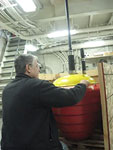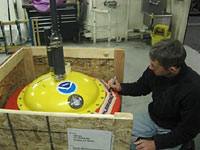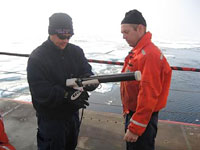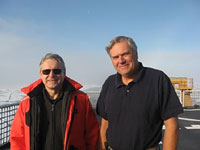

 | |||||||||||||||||
|
|
Journals 2008/2009Steve Howard
August 18, 2008 Larry Mayer decided to release me from my midnight to 8am watch duties so I can be more flexible with my time and do my job of documenting what's going on around me more effectively. I think this is going to help me out a lot, since I've been on watch all "night" and sleeping intermittently throughout the "day" when many of the other scientists and researchers were busy with their projects. Plus, I am able to get a more consistent sleep schedule and my brain is in less of a fog. Thanks, Larry! Feeling more rested and with a hearty breakfast of eggs, potatoes, and pancakes in my belly, I spent a good bit of time today hanging out with two engineers on board, Peter Legnos and Walter Lincoln. These two have designed a pair of buoys for NOAA that will be placed in the ice and transmit data about ice and air temperature and barometric pressure for the next three years (or until the battery runs out, after which they are considered "dead" and abandoned). Developing a buoy that can withstand the harsh changing conditions of the Arctic is no easy task. These buoys are specially designed to withstand both freezing and thawing periods, and are shaped like ice cream cones so that they "pop up" as the ice freezes beneath them and thus stay above the surface of the ice so they can transmit data. They also had to consider polar bears, which are known to be very curious and seem to like to play with science equipment, chewing on the rubber parts and batting around the antennas like a game of T-ball! That is certainly something that I would have never thought about! Walt and Peter are very friendly guys, and I welcomed the chance to help them out a bit moving the buoys around and stenciling contact information on them should anyone find them after their batteries run out. It was nice to get my hands and eyes off a computer screen and onto a set of wrenches and screwdrivers. I can just imagine some Russian fisherman coming across one of these in their nets 5 years from now and wondering if they just found a spaceship. Peter thinks that whoever finds them will make some very attractive flower pots with them! It may not be until much later in the cruise that they are actually going to be able to get out on the ice and place the buoys. I look forward to watching this happen.
Besides working with Walt and Peter, it was a fairly typical day of meal times, a science talk about plate tectonics and the formation of the Arctic basin, and (as always) looking at this fantastic Arctic scenery. Today I saw an "ice bow" which is like a rainbow but without the color (I tried to get some shots of it, but couldn't get it to come out). I also watched some Coast Guard guys deploy an "XBT" which looks a bit like a harpoon gun and sends a sensor down thousands of meters to measure changes in water temperature. This is done twice per day. Because temperature changes the density of water, and sound travels differently in water of different densities, this data is needed to calibrate the echo-sounder as it bounces signals from the ship to the seafloor and back.
PROFILE:
|
||||||||||||||||



